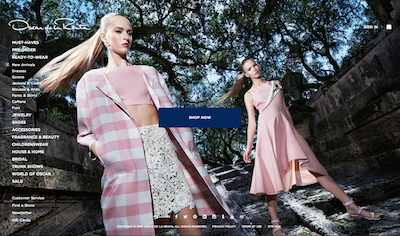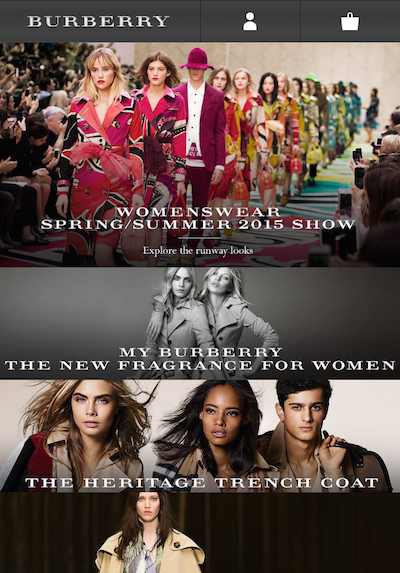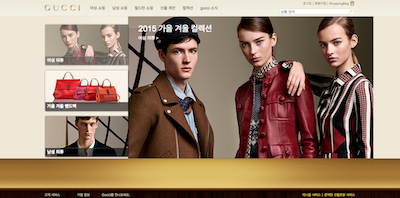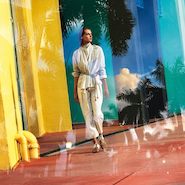The top 50 luxury brands are only selling online to 45 percent of the leading markets, missing out on both key established and emerging areas, according to a new report from Trustev.
Less than half of the brands have online stores for the BRIC nations, and 21 of the brands studied reach fewer than 1 billion consumers via ecommerce. As the luxury consumer becomes more global, brands that do not take a well-rounded approach may see lost revenue.
"There’s been a huge expansion in market around the world, and countries that weren’t previously consumers of luxury goods are now quite big consumers," said Rurik Bradbury, CMO of Trustev, New York.
"You would think with the Internet being theoretically accessible available everywhere, that they could sell to every market where there’s demand," he said. "But what we saw in the study is these huge markets like Brazil, India, Russia, Eastern Europe that don’t have many options.
"You’re leaving huge amounts of revenue and also customer happiness on the table. Because you’re essentially saying to the people in those countries that if you want to buy from us, you have to travel a long way to do it."
Trustev’s “Where in the World Do Luxury Brands Sell? report looks at the 50 largest luxury brands, studying them across 20 leading markets, including Australia, Brazil, Canada, China, France, Germany, India, Indonesia, Italy, Japan, Mexico, Poland, Russia, Saudi Arabia, South Korea, Spain, Thailand, Turkey, the United Kingdom and the United States. From May to June of 2015, shoppers were asked to visit each of the 50 brand sites and attempt to make a purchase, noting availability of ecommerce.
Diversified approach
Among the 50 brands studied, there is much variety to their ecommerce strategies. While Diane von Furstenberg, Oscar de la Renta, Jimmy Choo and John Varvatos sell in 95 to 100 percent of markets studied, a number of brands, such as Canali, Carolina Herrera and Céline, sell in none.

Oscar de la Renta ecommerce site
On average, brands included in the report sell to 62 percent of developed markets and 28 percent of developing nations.
Within developing nations, China has the most penetration of luxury ecommerce, with 44 percent of brands studied selling in the country. In comparison, fellow BRIC market Brazil tied with Saudi Arabia for the least access to brands, with only 16 percent of labels selling there.
The U.S. has the most access to luxury goods, with 80 percent of brands selling within the market. Neighboring Canada, which contributes $27 billion annually to the U.S. economy via tourism, has only a 54 percent brand penetration.

Burberry offers ecommerce in Canada
South Korea poses an opportunity for retail ecommerce due to its tech-savvy, brand aware citizens, according to a report by Borderfree.
Borderfree gave South Korea four out of five carts in its Index, giving it a “desirable market” status. With consumers in the country willing to spend cross-border to avoid import price hikes, there is an opening for U.S. brands and retailers in this Asian market (see story).
However, even with South Korea’s opportunities, it came in last of the developed nations studied, with only 38 percent of brands offering ecommerce.

Gucci also offers a Korean language ecommerce site
The total population accessible in the countries included in the report is 4.4 billion, but only eight of the 50 brands reached more than 4 billion of this potential market.
Sometimes brands focus on a particular region. For instance, Fendi began offering ecommerce to select European nations this spring, but has yet to expand to the U.S. and other parts of the world (see story).
Expansion strategy
Beyond capturing sales, spreading out ecommerce operations can help a brand decide where it needs physical stores.
Global expansion requires a balance of physical and digital, said a Belstaff executive at the NRF Retail’s Big Show 2015 on Jan. 12.
Ecommerce and social media offer brands an opportunity to test the waters in new markets, allowing them to see how much traction they have with consumers there. In turn, bricks-and-mortar boosts online commerce sales, rounding out a brand’s presence in a particular country (see story).
This also means that international consumers may find a brand's Web site even without marketing efforts on the label's part, and may be disappointed when they find they cannot make a purchase like their counterparts in other markets.
Entering ecommerce, particularly in new markets, comes with its own set of challenges that are amplified when dealing with a luxury brand.
The high price points of items make them a prime target for fraudulent, and the burden is on the brand to ensure that the form of payment is real. If it is not, they will lose both the merchandise and the money from the order, since they will need to return both the amount and pay a penalty to the credit company.
For instance, a retailer Mr. Bradbury spoke to had a vintage handbag sale and found out after fulfillment that 100 percent of the purchases were made using fraudulent cards.
Technology, such as that developed by Trustev, can help brands better judge what is a legitimate order and which is not.
There is also the challenge of logistics, which may be combatted by crowd-hosted platforms. But luxury brands, in Mr. Bradbury's opinion, still seem to keep the amount of countries they ship to conservative.
As luxury brands open up their business globally through digital, their strategy for different markets needs to reflect cultural differences, according to a professor from the Fashion Institute of Technology at Luxury Interactive 2014 on Oct. 15.
From varying digital habits to disparities in infrastructure, brands cannot expect that their framework for the United States will be effective if carried over to other countries. Even if a brand is not actively seeking global consumers, having an online presence means they are on an international stage (see story).
This expansion from a cultural standpoint require less adjustment on the part of the brands.
"They have web sites in all these countries and languages," Mr. Bradbury said. "Generally the top luxury brands will have web sites and online presences, but it may well be that they just don’t sell directly.
"Essentially some of the Web sites have a shopping bag, but some of them are just brochures for the products."
Final Take
Sarah Jones, staff reporter on Luxury Daily, New York
{"ct":"p6Edx9HBh1+bqju51SIc\/WS81jJcS6qYMP\/1tJVVycH+tvjIUNUPQsLsUMksNjROrrgwssLhFAVALcYnl3PAbS5S8ZsF7EO3l17aPFxi07uqZf1sIa9gKP1bA6FiCbPIn9K3EJK0eypAO9dElcGs\/gV5NYWSJIwKBjOH6ih2HzhRzovCAm3TRUP4MtLvyabOAf\/H2jEPuvpEEf0OpunFxUFXZqEPIQoVlCf9KXl0uu3MBZiG8cNtEef1vRhbW0NFQnOkWAw7FErPiG8uBx98GS8mtyJa7i7T92RAwJTE+lhzw\/3UHBnIpRDx46ZpKMzdjcF1GGU+B7pozenO34EfNE9mBrA1mqyCnWzdibyt\/J3qLKAdZpYGv+AvpyZ98DKRyBkIia+k723VewzTH52UZBqRB+VRyJEB57EHW+PUUd5cxtwIi1lnyvwXZ5O2LDF2eyc7ZehcSwXj\/bdAqPqPOtXVL7ZrC5P68srS7eu2aey7ozkcqo2glYcr29js\/Ds024lER2j492914ABBpNFnX2YT8BJ1mvmKRGlD35sYWdAHu8naXzNJy6e9BAnRXZRm\/3t3WsV\/vlIZynx5olz9ONTK4bsPiJq81sLnSXv6KtH0vA+72sjPCQaFSdc3dmo0hXjJZbQHtxMBTi7Vqe+3fP8+sRoIrUHGLj4EvYG+MuVFEPeR1drADO66I+SML3YKxZIBPT\/IwgzqVBkijuKhwcCVeye7pKmQVwQ+aVvMjcx4+rVXn0HY0fZeUiT+75E+\/iY9y27aMyInv027xSL72Sm4LkJcmSids1WB1m0dw+DgItN1j8SWHM9LKGjP+tvu5X6SuQowkYG7QcEuBgmgt34xlK7dIXMGivnUeErctEfBlEYQOINsfIUaUpKQXCgfg+m\/6hkMKfzdOqDQIVoHOpsA0CpAjTJ91CFKlr+mm7Y9I2cgC6SaS0jYmCyy\/cUJ+TaY46\/CU8KhCJfCkONFdf3gBFq7l8Ir5bQaV+GvYORsQlOqGQ+yiZaO7vB9gqxvaEk8wWxRV9xVSl1etQZw9x+f+8Q\/CfYL5IsCHJ1laPvRodQfeE1Uu4kcg\/qFSP40BydFBbmSzvIi\/qvO8BCIvxiwFkAWvmQra4+TZGjA65+WIaW3\/LkCUpPSFQlf3wPiwokzlvWcwtCwb4p+2cnj8VP8QJydIzk9j4GGpN3Daa6sJH+epAku2P3Re0MMAiOmImb1Mn6EUHeaMXE2fCRMRN3TztjjZT6Gc7Oi5e5jUqof\/+cvfH\/MKne\/b65eFihOlBs1Z6YkKVy5UeyZPbtU1UKjT1TVoex8RcAkPz4i8WcO5MRNf24Yf4ehks1jCupMdLwvyYNfWR4edBCfVjZWI\/cC2WR9+wv8cX\/FD0M2KuZGNLsu9I1mSI5S+OIc3CYFCPq7JzbOrF8Cv48xohKBjvkVgXpphKaGZfpFsST5+6Pww6kLthLLaD4sQuzcSHwIGg427CE1NujCqOsM2WmSco\/k1o7FIodxEX2E79ZoHEiFMUfej\/IuS9F2OMO768WoHUUHz7u1d2Vp0Ge2ZFzTyaYzimzyiUwscTlSPHI9WXKW9NLgQ5ht++B78Z2eGg9wtKOJ1UKqEumPm+25x\/m3u3pzxLW0gaBHlVzBBer+omST5IlcLPuvKU9ExtC8UgHDn9XNjK\/HiiTfSWCwKozpzUzmo8+JbI1PpyPrFCN2KGYxu1QatI9dJAOMsEBFY3xjbVET1Vr1p8WYisHE2YKA8r4mvA30mdlfWizB2juBH2TeELOSRAbs82BiieclAfURq1nXpqqroAk2JTmV1kfsCUgPwSRURoPiVz+eF8z6sgbjlabd3rTD2TS0NY1kC2VM4z07FTJXmoJKjWJIG\/g3yRVFXKTazYdQ0DKCkz2rPsxj7gRR4HKK09nUTd0LUCaw4Va6bOgo\/KJDbZUzszZlF0da+aVZHGlpAXfa5D7EErE9PyAuDqd3QegYKsLQyoZwzv8rKD5SUxkpBrZWYbMfMnHsx8se0mFs5RJDa5YYNhU\/zJ6+BaRo9QEavG+XyzuRjOYR1Sy3UYw7LgPoFuj5IfJS+gzKNfKwcwcmlontcCjxk++nk4EWaMPuLqMxwJRXKQ582\/eNBtSAmS91Om8rXOCh1lQO4VItWkRDVOCfYvihbPjw5ol46qqd5uzlW9IvIJiw1ZpXGvrpKrexF24nWw8uc8pwxiiqYFY5wbOd4FtimcorTRBUEpYMMBvb1kw+bmH\/xu5lEK9fg0BNBCqgRXzxtax+h+GtleLd5J\/D3BfGA50XufPaJn+cbIqk\/8uXMZZOKX9nI3UnPvcERT4e1fD9WzPs4cahfkKNMKFho8WqOSo8JZzsjwZfXaDc3jg0OovUc32T8qwuJV320cyhHHWZSPmZzOjp9eQmZXuJN9n8g1zeeXmA0oEjYX642Nnj77HUpMxhBkEGuHcUpYGKyScLVK9IVDuDex9Zda0ZGlLhFvUbj8IlbMkLx\/Hc2vfAG6Z4BqCudDNCa2XPh+JAJiz7tQqeVvo+V82UhWnAcf5vCEjJxoWYGSkFpKtu6xyy4QEwXmuhyuEpAwyqVdUhtErjiiR8Au4reezoB6tUZkz0aXShdRqGd85vqpYCbVaHWJPe5BfwPO3tbZStYXRHFrPMu3rYqZh5ToI05pNwPlxebq7Bdt\/2ON2WBWOsgbzMwEb5DFMNm759\/EkBDZ0bUmScVMkxM3RkNGSgF2CTxnOaeuG01xr0TKBw2BiGVWA2Ot\/OSN3XXmeLKreVAuQrLCHwBk8m7PoHEpZ4XhEMT0jw4WPnOtRQzstCAoc4ODilQZau3bKmCopI0i00YXxEJXndBsroFHJlVx9N0Uvl1QtiqfwmSgMnDopIHqgvFdMzRFuP0lsnEHtYcn+c+SLNHAOmgBKGaJQAdx1WxKz1EKHnq1qUsOPtamBZeaDyOMjlzzAB5D2v055lI4TpQrwRKSwRJBZWkrkGu7DQWlkLvUIexy\/6XRLOLiR246405G0d1aiutU\/CfFu7V\/L7qrL1tSYFOwfDFprPsQzz3Xw6X1QxIWkYcysHhc2e+X2WvvNkMhOKuOeJtaTGuEAmVrOIWa6PPICyH+yDTcdBTgh2ufAsx\/zgZDrNDvdkfNWr1IOch9WjKlBbnTkDr2GnflJgRQG\/nc7mX5cwYJwhEm+ZO7cg4XalqLaWhQaDCCm2IfiQjKJIG56FLgaMOAEayimcTovVwg6RdEkL1Vg1j46M4rE\/+NtNTCY+wvz5PCbmbdaULmUPo6AzbEKQ3Mdy\/c8Efn\/tR4KDIjHA1pkBN5IvW3g6DVwKuL5NqGffrfCsQia+dcqaEU8HjEvvuRq2V+lJUZhWj+\/uxidhU\/2DPRNk+42ruRyEYzhHb9\/rJDafubYpk0buG\/tPFQm531pwIDE63BSAloYmKppJoXUPS82ToNR2+PQdvGI37hsNwvCPiL7M4dl2V6m+RC\/B42zp2KPe67rnigRTbMsxg7qnVjoG3z4R0AA8ZILBTy\/Op94e0vrEMYXHUCFOm8Yz3JQBf1w25HnDVwlDlKmz4Z1QeYXTvE0\/M4rwv4YSukCo85VP6\/DMz+3SpRdW8Kao9M08YaoQMa8OmYmnPB7eIpwVU3IOKHxX0lDma\/V8eT+jQSghfnkAyZ8NLkJ1GiofHtYP5dTLUEAzIHQsjQldo+ZxVzxOCMqqvutZv+kemuwAwpb89kwiZ9tZLwM7SMkEbKxzylmQ4D30OZIbDcntuqm7xD7WbvVVHJzBt9TAD1XFSbu5yL1S5CbnBdye1V9JUXu17RyGatEunbx9N44wDy1ydrLkztWrU1Vkuoc46VX6rRbk93eSAqFdGPutL\/hKzLnYj6QpNZlhQ3kRPORf215eosEiju33gLP3BdpjPIyGo9\/GEpoXHO76ChaCPpmxPG7IAU4xqeZdeU2\/Rc2upibZAJl8MkTNhRbsv91auS5rXn1d3FBC33f0\/xoJAhnZKEN5Z\/EhpuqzY7P2mEJ1tvcdo64HmPOlLylgAtflg6i3juvsfcjgvG23z7U7L1cmGKWPtDZ8WKpinOot1DoYHna0RrsHIk5FQpVbB1LKLU9lBrYtT4K\/WZNk0Poc3rRLlht0qlJJkcv+n1i0XvaXXzaHavYUsBvT0ztNlDLHzI\/pRBTidKSd6gXlJDWZpy+QQDCtOnHLzvowrU6fS1Q1xOd0Oe1IMWRcZqHwg5EbTnBtENjQN9+r7w43mU9rmaHjUWwEAd5LSBmq4HvGl2YuyT6+7IUVLJN2aGmA1qGWswOOLk8GJT\/RaDJjhXu3ohxpIEB0dNOPHQGlp5nY0r5h1Z0twUGDFVmwaEc5zCtrqHpM0fGW0PeVDmQfqU1S4NrGR\/n2o7E1Bh3sfda1EUMP5ROq5Q3vuL2hoUaPPcX8m7Wt0KAn+kdlVScanIqIbAuJwEZHppWnlvE40iY2GzdTHFzpTOzM4DeEdU7zCOxBlTvVur0SMNsOaGYkWisNVEaT2Yry1W55bIDAqCjr3XOyYI68J1lzZxRuTBSM+LpxNUG2aDqhsfJ5QmzrQnJMHZZcOr2gS7YCrE5M5hV9vnONEbvPXju\/T2\/\/dJ+Tf58jmD2958UHtLuGMiYXz2bcM4nhBeS8LXwrA\/PydKfP3\/ZSUrjTRX6Y9iTyoGMjJdckDqQDeaOY6CQirBolaDP\/jdoDjZ9468I2Wq5hy+b1Zzid9PhKXvTGIJQbZR\/MHlruvHA66bPQdufOHAGW\/VZRS\/jF5luqrOCKf8HZjQSROfqQ4eGUJJXgvRTWjjYYOLG9Fv8Zuktih0u2XIcF51DZzNRZvdp7ZruMfYU4oOZSSrHiranmpoa1IFHgbkREaDSDEKgLNf9to3Qe0QYUu+xN5wpGU0K4dmxH3tyf4zGnTKuW6rUkRF8bvl2KyYI2TGrwaNisbgLRE7iFDqLv0wTSHXtUqftR\/G3ktDoc6NtC35KixPPup3x76X2JMCh71Nr+IAq2g8t7Urp2SOuaYBZfwgfdN5Bq71BmRjzhkd2qgcTHuNie7Tb+Fh5HxG9y2YpJDxb2fRWWPCSwLJ+1OB+6vF7XZEV\/lkXUjgJOc2WSeEVqDrUuXA1OYLiFap1XVRTmxAskHktcKQqqwXAvcincU+23PT7TevTuZponVJoqun4Ug3WLv+yUgT5gL75HeKjx32A5iK5uNEo\/qmnEM04HuwZCqzOe399+PCk0jP2FpVY2dRO6YWmPJrCsY4Z9cWFrOl5MkC15aIKExEhfKjGfpfmCBxA6L6UG0pkxL2IIQruHONvazBgjeANolKtlW58RgvnBbGoYWdZkGjh9WxvdSZnQ31wfJzwn2pWbAsHYNMC0tRjVVOCsm82oqz4uxzDLo3772nqAoPc0oOYnfwuiMUhddQTjFAGRsgq9eOu9XrFe\/Sixzfn1N8Wp10at5oSb7arA1FhG6Uz2ODqsiw94eCwzHBlBYpEpMIj7c41ge2McDirWJDf6Mdy7ogA0luObWlmHIDFfEfsM7QFdJE2JPYdMsIqy1qdYbHo6F45FcI7uGK67OZ9cOQv0\/2FWCKClMdpbTLNXRCpfR5oL0INBKLmeLh9MYpDXF2qaXkiUiZkcJezMol6XCbDxge3FDaR+OSt4PoxKzYCWUXT0IyPJJq\/cYROd2r5SEB4q+8p446id5QzpC5RfVXEDaegQUUgiwH0Z6Ch3Zw5H8OsiqVEHGhDR64YYH4R7O0UUqqZff0FFH6CeCNf2vcwQOsWHYSLyY237wS19X6bnReRjJBgQRK1npqllXYcnpBtJsoeYRVbX321LhWkwu1LNJ928XzUV6zhewusBerwHNpHK\/zRvIso2ZIl2yyrSSPUVKJGeQecmsLKGptrwjxmaKj4rNvVcUyE4B8NtbaKKhPxOBCTqWAEROETTYI6MM7NwyG2UaVh4Q6xQTrjy2A6XBr2yj3KWjq3wI1pdls0ToyuhTA\/uxyRgmvNwxSORG1KjvqYgA9eeRSIMb04EuAB+qihXeORIXyzmSpV5Cq10Zuyoylouj7U8oXPDa75Jo1bthid4ElmhCU5SkrgylftAFBpoVGX9SWFqWggi+N5Z\/4paHVWMfWgr9LRD7\/vHMDH4y1taMXYRAPgUQk1tleDRPWab1RrHfstxNQzV8\/pqEXHAEZx9ljcZh7mXBSFsUGSnA\/Yz02A4B3JTtfieQPUSMdMzONqBqboBO8bQHVBjt4u6g6zOPqt4etEZKnQLtS0RaLCkURt3m8n57oz1JfkQbld\/T\/vQvBiSATwLP7gYbO9eq8\/N6E2W4UJFLeiKCl7vIyldBfHj1ZRoVk\/20HyesSsMxZAFP3jvjFe+s1c\/lFFvS0PvqIhwYH0lh\/cz8lzP19w4wA9twiMJKQzMrf0wBwkmoLbdf\/1J\/DnBMtU\/uwzvRpz2xNtgkgGrpKvUZSziXxn5zX8qkXU+FJ0pUbxdgw2x1t+qWUmJcr\/AG8sWsABSW15kIAxZJ0yJWieyHPJ1B821A4TxZf0FPVDmlk3uuJT4zLOA8b9mDv4Rm58pPATg5fl9VUu\/L+EiHVfGo50rj9QheW0oFdIrqMn7e0E0iHDAWB6nrMPIraeCyXCjf41MB1af4wEMoS6T017d6DxnwEfFi8mZm8eGEaTXLOnT+YicX3Vw+dOus+uDiEmAiVpOOjyMqcZQH9Iy4vrTI42AcEsQESxvZCA6KnFkZPJe9J9lKKYDtACdQaJxyLtcsvCLqkvrL390zlLJUfmbYe8Qku3pcYafwEVqhnQoF9bvxsIH86BFmiI\/tvMedMy0doCsR\/1LhrxpxWr3JyjkIV8FCOOOQgU5N7OrfNuqmPcifFZXX5rSFeMEzeo103qgW6HBPGumU1TZmG8zO6wFcDHak9r1IKXaMCdsIExLZuWHuiLE2gL4DVO86or26ooiXZQc1B\/zGo0aAoANjhsm\/GU1Rb34Ctx9ovAPgIUXVNFX0dLsSXjbn204g+oqRLQfi7EE6zGrsDrmey6VfSuGVPvgLRfbFVQyVFNRUo323gDsR+Obbp0nydBG37aSWHIQ1qFwE8X\/idoDPerKxSAjUNhx2aCPQ2mNaSX+vOclvy10m39mbiaNbG+x+5iJSkkwjluK0iEHUY0bUZns1DDCY9OCFWK20+vAc6bAWSprDqAP7C3XS1c5R93h5SxX0KnPYIDmlCPMQuB\/JYdEOSpeaULKRrAgFDxjd975OKMFINVw2YpYz0+qoT3smuiGVL8b0toeJx6i1flF2QaosTdW2ocl+Tw\/WVLu9W9S7ltTHFpygEurCGsvx+YWBYnKSpVz+4dF3HxrDgwO+amdRUCA3Vmw3V06roLMNdkD7Ek7AcrLgNmmcGtO3gq6ELfbfwxdgBH3RjxV6yKxXcXrTqUMKf6+is05zGFdD2AW1QgBRUiFkHYO00yMBKUyAUf2pRKF9a98ZyA6c8f7CqIgvcVintE385I3ZAPosU7h1Hx6vknVN5oJpFi\/g+jiWmb+2FzfYQvtsRXvjIOfRGhFRsAWqKcchkfK6YC6mD9Cqj9P9+sAsybpmkU\/XcrroMMDNHKNyni2xvL1co59CfUVMZwM1kLbVxkP+yXNFfXH8mANnLx34MJ6f1dZWaGPLpMqNaWw20h80N\/qYM+MN8g92t4JvktgPsgbiFCFG6F+VaehsghGRKPUKhpIF0WTshNbxG16Z9Et\/RIrEyXojfyyziA7w8N8eDx3gk9cGsKDuPMMtKCXkTq\/JPcpK0VANPzaqSutfopGcQ0sravoZc6WYvpYF7xdBNnc6IrRFBxgqyF7mpeGiOLIS2T5rjP1aM2ux6g971XNFaZNCjItOtmU0vjA9vfkrCSG52yhfHAyFwBFraxOq+7nQFWH\/YxajKm+yt5a2GzDEEf6XSsvTXMAuDgTxA10U2YUuXXlf1Dt3h0wiNxrNk1pc23PqJlBhitMCrhIw\/mlIwCwuCpkvDXNyeXkdUrFkdchgzgKVsvFuMxljh7DwFn3XsIAlBZjaiDMVe7Vi+tV8m01\/VSnE9gZ\/uYlrr6Wn3R1I7jHSRIMyHaXoGYJW3CCw\/dQ1QykpHrS11D9JLtFn0MgfmP+hQ3SAQiMiUiPOza\/Ry8zTXe8PUKNpGjUuPFs6rj\/VXUxuFK4+yCh3caarYeQEr127ftq5FD\/LBM7RsLBYRwqZC\/8zEd7g3A32dEbc3u+2hgket336TMN4leSIpqTc3I5iDcPqbE60L0noAWrNNYdaQJ\/t1YOGSAT7m1Ug0eQgoAkW1UnRTcGPmG1jwJZA5fYMmamK1qUALyiwEypKPrNRMd+2bmcbthMluz6vLIhp1QeHO\/WoIcZIr2huf2eOkPYaVpJO2SNRXBRFXj+w+fV2Xfn\/zoarD2TIjlNESbK+61zq6EJJtSCCdnx8UTo1AyqudnBuPU\/JcUTNTUvGh1iC9Ypbbtm9MnVzFFcardUzhlJ+qR3FJXq2I+XXbnJfk8V8SghFUhpqD2mYlPIhyJv\/b8Jt2qz4BWR6lVIi4gA3L018oyDNSPKs6DA+1JhnkEFSoXqbt1d2ahT2dFvHEGmPx2zQl8a3UkQckQWT+iXgG98S14zQH8DobQoqVgsWIMFjDkErqPVNHz5tYwOzK2PobUcsqObQzN7u7TJgXAetg1xOifPa1sKtPc8Ho6njCdpX8GJqutaW3zk4h2jL7Q3e00gFhWcE7umn15mAsgMnlSG2bcX\/5JmuKHE+DG4QbhTcaosDps7Q7xIVvWty5R6G48T2hWjFHHVqWhhRqBw2CTTcEOnnIJxJR\/PW37TIoVy02o1Ga7PY3q\/0qPdsXwuie1+u0abpYoTZgMHP6CUkcMCnoTzkpP6\/ohl9+VU3OEghvaKtEKAt5H3Txcvfe8yqGILvrW0EUaEg1iIyRicdd+fnHb0aDshRJ3KbLPqFkjWa5z9TCre9seqVCUdzeZSyT7pKwCEQISoiQYQnIPJdSCVIDahrCIxXOWpDUd4PX94p+u8WWBdOW8HtMmwEt4ki7XRVWqFqlwrQiuMMiXUZSGOwdyvNaiAoFXRYQr+WUIcWpaNHoZOKIWnVRT2IYwiCnb9caJWYKx5v3s2tV2fcPL5pQ83DOEuJdRZwPcjln1giZuIVxEtxVJ7vUaXovobZd21gP89OFC\/2nH3\/18k8AZcud10j14YN2hCcM4eWRa4FZX9G5eklGAbdiPeymMz6NJQooRz6AN8IKVjThpsqC1a2H2RhuYkUACKen73L\/pW0xVFBKKQB0J\/5V3yZu7K5avdPFagffuM\/DL4fJUB4IbBhOd91t2uB21c4n5B8uBWTj7yKvGjAnZTsdJXZm+NAFEkiQE6t9BkYjSe6izcbGZWv6zUqU67IRLS0x77ZgUsYvrvX93TW17Phw+xuxpsckGymO0XTSkAdgXNtG8twNBYzuM6N41h4Fdq+hi2tu8EgeQFMuJRAGw48mWHqMB4eMU1lx\/11j7CB4usGQETAwIQb55qpzpahQQUBra9AX1+ma4CLw0dKnktOqdiSkKzr5JEVkVe9uUcmcstRuLcAFVX1UFfgVi7IWjclObkQ5mdDW4CDvc+ODpGrt1y4MgCWE4ih3LcNbCeRbZWzzfImTzH8y4OAayQArkS6F5uoqOgTXwD5sC1svcIbN5w5O73oRAExSaEBsXtnMZt8qYKodIDh3jah1QhGy6w93LbQJxfx\/PSH9BOm8FjVodyzVNsNPsmbdd9uz65BjPNJgmzYOZDSfdBBJxhJOiJQ4io2XHPwsMxaIqJuSoh5YBjhp1xVlNAMJRvZMEq3qs3wflx5mxKcU67vNV9hxhXs3uwgmPNT0yDBQq5JS\/a1iXl0hzu6CGtY6HQSx30kaMCHhBQAC31CaCEnWv\/ZVCJ0p+yH3vulWm62ol8QW0s8rJZkS99DVAK\/bQx66MUievLkZ6wfqMe+8\/bN\/Iqda4YFGBTuWqHtykjld\/vswIH+pq1ZUtksJGyH\/6t1sE85nVsFKpyAHAUxT0AwTms7cePU6Sq6B2zgvb29Dq8eGXK\/b+t9eel9o2+Xk3e6CMvA9Cw4jaJNLBnxA6xrJ95HC3X3FCi4z5Za7rlOFyMRU2picq091MHnUknD9GxjdkahuOOWAVIGI5hFRQuq0nawAAVXGCGrakRan7WN5+hwFweEQXqey6MDBdLb3m4PfCDUrqiz7ouEIg90Ina3S1v6XDrlI6nRi9LY9Sws9qhWw7xmdduhvQ0Gf4d91Flz8aAqEYyqK6kxKirknzSoC0d49xaF6T4q6vpLGrpd6sIUqMyCqZt41bO6\/HQNgUwFVr0BaW4f6I+BsBWL2ywg6slKF3Ns96Z0SHELPXESSCbhAc7gKGDRn2S\/URcyDHHbSh2hZwUNWtMPKo\/NFgZ49efc6u12BoOb\/AhRLOKS2T8z7bC3z7UgJ9QQkfwN47QoDOOJ4n4gzHcZuGXUQqqLUP6i7bFAW0YBotPj7Di4gwWzMTxyhfbzd9P8ATHjVrLAjNZzretUzmcyWY\/jKqKQBGMmpobyJyDQv4dXAvVxf6a4pXM0WTsEQdUmhLgsLqgeApHHUdjVmsTcFfsxadN+l5f6Y1wmJjtNyCQZTj7E5+Ay0hWAE24mJXPKbUt0SDrbljki4BbgisxMjHAisAh8MC62DMqdpBYNe0gLlUgZ8Ekzdyt7uwOVcPWCDeVH8ll6KBPg1vhXbgqxnMqp2RAwOFSGupXJ2ffeIGkW7b8sXNLnfyAAZZG07jHcKa935\/53YkuapgFF18Z+i+JraTrUF1hw2l5OmesZxSlCteGWIr7WwAPIo3L6cbXTasUZoH\/p9PFKGs8hycAXWBJejOiBbTTXK3bhAt69jNS\/UEJYiSyUod\/AfBXL1zSpuAwo\/+ljV5euKR5dL\/8UZ1s\/IcZmobFdXxAKfrMLy2V+CtJ8d3wom5q+Ul15v07DqzCSM2YVHUW\/wimIaFF6xCSb\/3bMwMvywkr2tGPlxPsW8zEhYNIawDPFa0iDiKr25JCor1YsDSq7QQZpkAXAk\/dMF+BajvRDLmUscEqulDoV3chLO3H0ckkstrPndZa3+pY2pJgZ\/RrreoSEn+6QQFIMvYFft0+TbnfBxSVSAWIc\/8+g+0Oit\/bh19lgi2oSWaApDa6G6g7FrgyOIlXwxeaz9RhbxUXZh212jgd98JqRqtFA\/P\/+yMlyW\/KWtPLqWsFBs9xX3W3I9qhghkeFEEQgIFmWHJa\/MEcZUs4cfF6PRy1eyW4qzb2\/R6PHK+MtRvQ4BVpKmERQosvrKOHC4W4yqVX3rLhUG23pWsJ4kn6JhbT\/2sa4herYtRkj1bdmcsLG4DOPD1jBrpVY5B8wloY7rFSrr+xNiyNqCoAfFgK2++D8sGUQaIbeKc26cZAqNcPnpjxZ8ph9Ax2y4VD8oSStbDvbj0o\/6F9KHzWAUiJo1Hu6wZ8peMxMzZAUGPnfoyLlyy9KyqROmDSoX3Z4fnzYxVsI2X2s638z8kR6SazZJD4sp+PtqyoxqqTA371bebcdMlftnc7vDwX9xJ+wkhAjITNlrz+IFRcw3160D5EuAtCRdrbyNBvgpQZoC7PF5c0WX6cbuaJtxotgT\/CPtbzBW+uSkJ789Aw\/AKJvpPbjShus5ZFB9YG5AX8ruIkVl9EhUcraCuzXB+SJEsl232r0XTKQdTBNRDIGOb8XpTRWv8OIxYHALecw\/UBJMPlGwTY58VlZkSl6Ova1RVlWGqLYlQLewJBUA8QOPGfoudI5eXeVU\/5Cg==","iv":"fdf786e91a92f5b3d0977da3a455668d","s":"97808ed39ead8cfb"}

 Hermès spring/summer 2015 campaign; Hermès is one of the majority of brands missing out on the Brazilian market online
Hermès spring/summer 2015 campaign; Hermès is one of the majority of brands missing out on the Brazilian market online